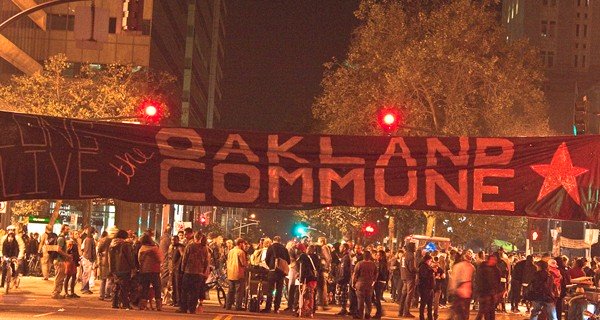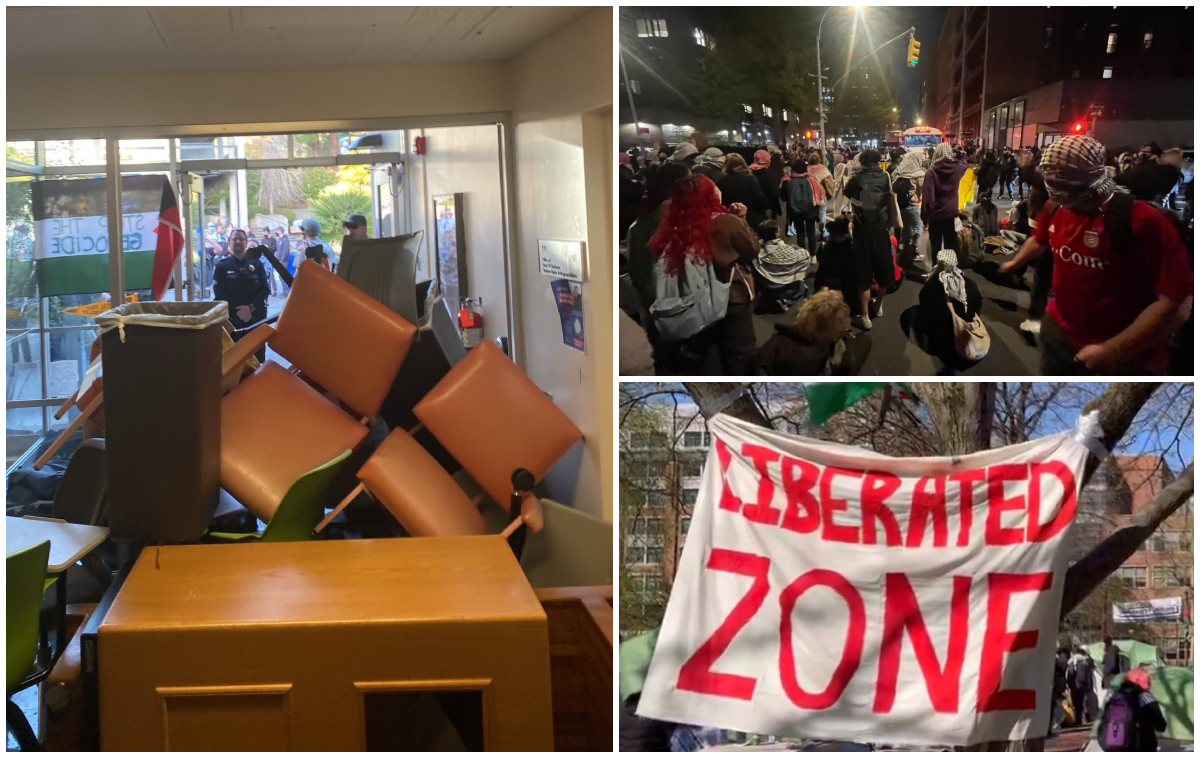Filed under: Anarchist Movement, Community Organizing, Editorials

The anarchist movement stands at a crossroads. Interest in our politics is surging, and collectives across North America are forging ahead with new projects and battling the fascist threat. But it has become clear to many of us that our old tactics can only bring us limited success. We have to learn from our history if we are to achieve our true potential. It is time to overcome the old division between insurrectionist and social anarchism. The new anarchist movement has to combine the best elements of the radical tradition into a coherent force for revolutionary change. The new anarchist movement must be a mass movement with the strength to overthrow this decaying system. It is our duty not only to fight, but to win.
It is undeniable that anarchism would not enjoy the platform and prestige it currently has without the heroic struggles of the insurrectionists of the past two decades. Alongside the Zapatista movement, the Battle of Seattle brought anarchism once again into the global spotlight. Confrontations at major events and conferences attracted new people to the movement and forced a conversation about the destructive nature of capitalism and globalization onto the wider public. Eventually, however, these confrontations took on a predictable pattern that state security forces found easy to contain. Moreover, insurrectionist anarchism was mostly contained to smaller social circles rooted in local counter-culture scenes. While structural factors played an important role in limiting anarchism’s appeal in the 1990s and early 2000s, our culture and insular outlook also prevented us from reaching a wider audience. We cannot simply repeat this self-limiting approach and expect better results this time around. A revived insurrectionism, absent other practices, cannot move us forward.
The crisis of 2008 opened new opportunities for the movement. The insurrectionary rioting of 2008 in Greece was followed quickly by the Arab Uprisings of 2011. These uprisings showcased both the potential and limits of semi-spontaneous, mass mobilizations, providing a model for Occupy and the movements of the squares. Again, anarchist politics and practices played a key role in these movements. Many of today’s anarchists came to the movement through Occupy. But as many participants will tell you, Occupy and its sisters had many flaws. Consensus-based general assemblies often suppressed initiative more than they encouraged it; resistance movements rooted in no particular community ended up being dominated by hardcore activists. Momentum inevitably dwindled, and repression successfully broke up the occupations.
Even where ‘spontaneous revolutions’ successfully overthrew a government, as in Tunisia and Egypt, they lacked the ability to force wider social change. When power lay in the streets, there were no existing social structures or organizations ready to dismantle the state and build a new society. The Tunisian and Egyptian revolutionaries are not to blame for the mistakes of 2011. They did not have the blessing of hindsight. But we have a responsibility to learn from their experiences. If a mass uprising were to occur now in North America, we would likely run up against the same problems. Absent an alternative form of power, the initial revolutionary upsurge would be diverted or co-opted by powerful, organized institutions like the military, the intelligence services, and the Democratic Party.
Social anarchist projects, from Food Not Bombs to solidarity networks, have also contributed greatly to anarchist practice. We built trust and forged ties with our neighbors, practically demonstrated our message, and helped our brothers and sisters to get by in capitalist society. But these projects are long-term investments that require many hours of work and often receive little attention outside of local communities. Moreover, it has often been difficult to highlight the links between our different projects and explain how they relate to our larger vision. Social anarchism also contributes to the movement, but it cannot stand alone.
Ours is an era in which mass movement anarchism is once again possible. We do not need to dilute our vision, moderate our ideas, or engage in petty political maneuvering to get people on our side. People are attracted to anarchism and anarchist ideas precisely because of our refusal to compromise on the struggle for freedom. We can certainly do a better job of communicating our message and reaching out to a wider range of working class communities. But more than a new message, we need a new model and set of practices that can push our movement beyond the present deadlock. Some of our comrades are already developing these practices. The key is to link them into a coherent strategy.
Our aim should be to turn entire communities into strongholds of the anarchist movement. This strategy is based on three pillars:
- Community self-defense.
- Community self-government.
- Mutual aid and communal solidarity.
Without self-defense, there isn’t space for autonomy to survive. Without self-government, there is no way for a community to take control over its own destiny. Without mutual aid and solidarity, the vicissitudes of capitalist life will wear down militants and community members alike. Combining these three practices with the bold, direct action of insurrectionary anarchism offers a way forward.
Both the Black Panthers and the CNT-FAI enjoyed success because they simultaneously employed revolutionary, insurrectionist tactics and a social, mass-movement-oriented approach. When these two elements of their strategy were severed, as during the split between the social democrats and insurrectionists in the Panthers, their strength quickly withered. A movement with no base cannot survive for long. A movement with no teeth has no ability to make real change.
As we build people’s power, we need to continuously emphasize both the insurrectionist and social aspects of our movement. Projects like Portland’s Anarchist Road Care, for instance, deliver this message perfectly: We are both the people who fight the fascists and the people who take care of the community. This, of course, has always been part of anarchist practice. But explicitly and consistently making this link will help to create wider buy-in for the insurrectionary elements of the anarchist movement in our communities. It will also demonstrate that we take the project of liberation seriously and are willing to make sacrifices for freedom.
Successfully pursuing this strategy means striking a careful balance between the necessities of security culture and the undeniable benefits of open, mass-oriented organizing. While a group of ten trained fighters are often more effective than a thousand scattered individuals, it is better to have a hundred adequately-trained comrades than ten elite cadre members. What happened at Auburn is proof enough: even the most capable antifascist warrior can be overpowered by ten cops, but a thousand-strong antifascist crowd is near impossible to stop. While we should continue training ourselves for effective small group actions, we must spread the ethos and skillset of self-defense to our communities as a whole. A lack of proper training for militants is extremely dangerous, but so is allowing militants to become isolated from the wider community.
Our ultimate goal should be to create a network of communes, or liberated neighborhoods, with the power to defend, govern, and provide for themselves. Insurrection and revolution should not be the special property of a small group of activists, but the aim of entire communities. Block by block, community by community, we will build the revolution from the ground up. When the opportunity arises, we will have the experiences and structures necessary to govern and provide for ourselves without the state. Rojava is the way it is today because activists were preparing the ground for liberation for many years before 2012. It’s time to bring that foresight and determination to North America.
Is it possible to conceive of a neighborhood or town where the anarchist movement predominates? Absolutely. This has been the case in Exarchia for many years now. Despite not being an explicitly anarchist project, the Kurdish movement in eastern Turkey and Rojava has made incredible strides in grassroots resistance. The critical question is how to get ordinary people involved in their own liberation. This is a major undertaking, and it may seem intimidating to think about how we can play a role in making it happen. Start where you are, take on a project you can handle that addresses the needs of the community. Even a couple people can start training for self-defense, finding ways to feed the people, or checking police abuses. Link up with like-minded folks, whether they call themselves anarchists or not. Do what is necessary to get people’s attention and inspire them to believe that they can free themselves. Don’t be too frustrated by inevitable failures and setbacks. We are in this for the long haul. But if our movement can start doing what it takes to build a popular base of support, we may find that the hour of reckoning arrives sooner than we might ever have imagined.





